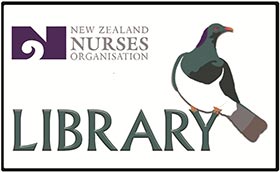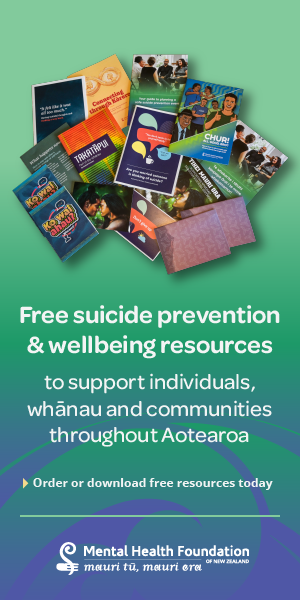These can be borrowed from the library by using the NZNO library enquiry form on the library’s web-page. The loan period is four weeks, and all books are couriered to you, so please provide your street address when requesting items. We also ask that you bear the cost of couriering the books back to us.
 Among the many services the NZNO library offers members is online access to articles from Kai Tiaki Nursing New Zealand from 2003 onwards. These can be accessed, as can a variety of member-only databases, via the online databases page on the library webpage.
Among the many services the NZNO library offers members is online access to articles from Kai Tiaki Nursing New Zealand from 2003 onwards. These can be accessed, as can a variety of member-only databases, via the online databases page on the library webpage.
Contact your library:
Website: NZNO Library
Phone: 04 494 8230
Email: [email protected]
Century of service: A history of the Irish Nurses’ and Midwives’ Organisation, 1919-2019
Loughrey, M. (2019). Irish Academic Press, 382pp.
Backgrounds the social and economic conditions that gave rise to the INMO. It details the organisation’s changes over a century and describes the services it provides to members by means of interviews with union leaders and members.
Communication in palliative nursing: The COMFORT model
Wittenberg, E., Goldsmith, J. V., Ragan, S. L., & Parnell, T. A. (2020). Oxford University Press, 308pp.
Outlines the components of the COMFORT model of palliative care communication: C – Connect, O – Options, M – Making Meaning, F – Family Caregivers, O – Openings, R – Relating, T – Team. teaches nurses to consider a universal model of communication that aligns with the holistic nature of palliative care.
Community Health and Wellness: Principles of primary health care 6th edition
Clendon, J. & Munns, A. (2019). Elsevier Australia, 325pp.
Focuses on the foundational principles of primary health care, taking a socio-ecological approach to the health of individuals and populations in their personal, family and community environments. Incorporates contemporary research in community health and wellness from Australia, New Zealand and the global community.
Death and dying in New Zealand
Johnson, E. (2018). Freerange Press, 159pp.
New Zealand’s diverse and ageing population, advances in technology and medical care, and the social, economic and environmental challenges facing New Zealand society, make this collection of essays on death and dying a stimulus for discussion about how to plan for death as individuals and as a society.
Emergency Nursing: 5-Tier Triage Protocols
Briggs, J. K. & Grossman, V. A. (2020). Springer Publishing Company, 305pp.
Delivers essential knowledge for accurate decision-making in emergency triage situations. Addresses adult and paediatric conditions in alphabetical order to facilitate rapid acuity level assessment and their nursing responses.
Essentials of Nursing Informatics
Saba, V. K. & McCormick, K. A. (2015). McGraw-Hill, 886pp.
Elucidates the role of informatics in every aspect of the nursing profession.
Ethics at the End of Life: New issues and arguments
Davis, J. K. (2017). Routledge, 254pp.
Presents 14 essays that focus on recent thinking in the field, initiating issues and lines of arguments that have not been explored previously, while orienting readers to established questions and positions in end-of-life ethics.
Final choice: End-of-life Suffering: Is Assisted Dying the Answer?
Trayes, C. (2020). C&T Media, 276pp.
Interviews lawyers, doctors, ethicists, clerics and terminally-ill patients for their views on legislation to legalise assisted dying.
Health of the People
Skegg, D. (2019). Bridget Williams Books Ltd., 144pp.
Argues that the Havelock North drinking water contamination in 2016 that caused widespread community infection signals an underlying failure of public health policy in New Zealand.
Intergenerational Wellbeing and Public Policy: An integrated environmental, social, and economic framework
Karacaoglu, G., Krawczyk, J. B. & King, A. (2019). Springer Nature, 247pp.
Formulates an integrated framework for public policy through investigations in four domains: a formal stylised model; a policy-informing simulation model; the implications of introducing fundamental uncertainty into the framework and a viability theory.
Leininger’s Transcultural Nursing: Concepts, Theories, Research & Practice
McFarland, M. R. & Wehbe-Alamah, H.(2018). McGraw-Hill Education, 466pp.
Integrates cultural values and beliefs into an individualised plan of culturally-appropriate, client-focused care. Presents a comparative perspective on western and non-western cultural care in Kenya, Southeast Asia, Haiti, Syria and Taiwan, with insights into rural vs urban cultures in the United States.
Maea te Toi Ora: Māori Health Transformations
Kingi, T. K., Durie, M., Elder, H., Tapsell, R., Lawrence, M., & Bennett, S. (2018). Huia Publishers, 333pp.
Explores the relationship between Māori culture and Māori mental health. Discusses aspects of Māori health and the importance of culture to diagnosis, patient history, understanding causes, treatment and assessment of outcomes. Reviews current research into, and knowledge about health and culture, while providing case studies from working with Māori to restore well-being.
Measuring Capacity to Care Using Nursing Data
Hovenga, E. J. S. & Lowe, C. (2020). Academic Press, 476pp.
Presents evidence-based solutions to safe staffing principles and health delivery strategies. Teaches how to use informatics to collect, share, link and process data to meet health service demands. Includes measurement of nursing care demand and nursing models of care.
Medical Cannabis: A brief guide for New Zealanders
Holt, S. & Dalton, E. (2019). Potton & Burton, 133pp.
Takes an overview of its history and summarises the latest research into potential benefits and risks of using cannabis as a medicine.
National Code of Practice for Managing Nurses’ Fatigue and Shift Work in District Health Board Hospitals: Safer Nursing 24/7
Massey University, Sleep/Wake Research Centre. (2019). 63pp.
Provides a ground-breaking approach to addressing the challenges of shift work, long hours and the fatigue they generate, which are inevitable but must be better managed in 24/7 nursing services. It merges the latest science and safety management practice with extensive nursing sector expertise and experience and is endorsed by WorkSafe, NZNO and the Council of Trade Unions.
No Shortcuts: Organizing for Power in the New Gilded Age
McAlevey, J. F. (2016). Oxford University Press, 253pp.
Examines cases from labour unions and social movements to argue that the social movements of previous eras gained power from mass organising. Concludes that progressive movements need strong unions.
One Hundred Years of Purpose: Hospital for Infectious Diseases
Milne, K. (2019). Society for the Prevention of Cruelty to Animals, 22pp.
Recounts the design, construction, and varied uses of the Wellington Hospital for Infectious Diseases, now the Wellington SPCA, built to treat influenza patients during the epidemic and later TB patients when it became the Fever Hospital. Backgrounds the training received by Wellington Polytechnic nurses during the 1970s when it was known as the Chest Hospital and profiles several nurses.
 Population-Based Public Health Clinical Manual: The Henry Street Model for Nurses
Population-Based Public Health Clinical Manual: The Henry Street Model for Nurses
Schoon, P., Porta, C. M. & Schaffer, M. A. (2019). Sigma Theta Tau International, 337pp.
Focuses on the development of evidence-based public health nursing practice in diverse settings. Builds on the Henry Street Consortium framework of 12 competencies for population-based, entry-level public health nursing.
Rising from the Rubble: A Health System’s Extraordinary Response to the Canterbury Earthquakes
Ardagh, M. & Deely, J. (2018). Canterbury University Press, 302pp.
Recounts how the Canterbury health system managed to maintain and rebuild essential health services following the 2011 earthquakes, based on first-hand interviews.
Spirit of Māori leadership
Katene, S. (2013). Huia Publishers, 237pp.
Discusses different styles and models of Māori leadership, identifying the qualities and approaches of Māori leaders. Describes six criteria to guide nascent leaders.
Stories of Resilience in Nursing: Tales from the Frontline of Nursing
Traynor, M. (2020). Routledge, 107pp.
Uses narratives to explore the concepts of resilience and identity through stories told by or about nurses. Includes contributions from mental health nurses, a former nurse, student nurses, a migrant nurse and a whistle-blowing nurse. Concludes each chapter with material to promote reflection, discussion and further reading.
Tooth and Veil: The Life and Times of the New Zealand Dental Nurse
O’Hare, N. (2018). Massey University Press, 256pp.
Backgrounds the post-World War I formation of the School Dental Service and details nurses’ experiences on the front line of dental health. Reveals what their experiences imply about New Zealand society’s attitudes to women, work and children’s health at the time.



